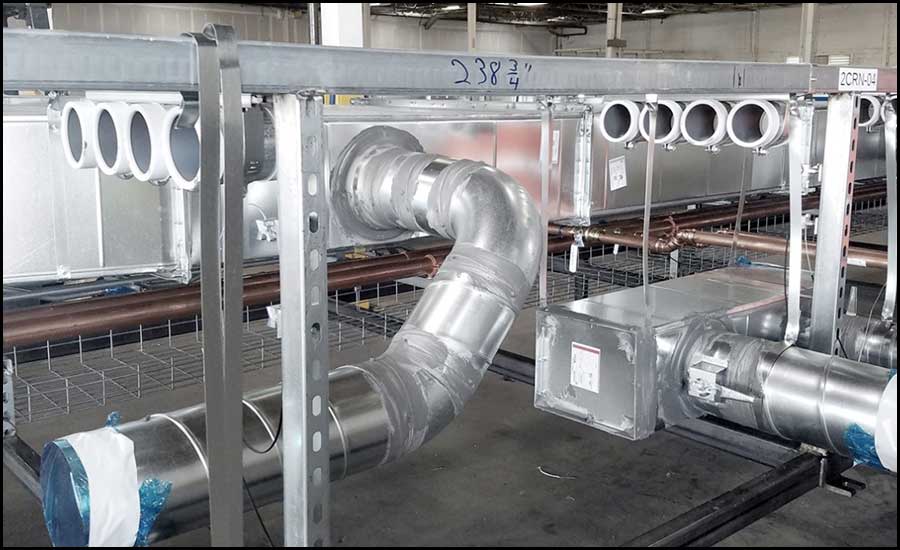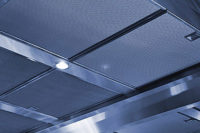Sarah Cannon Cancer Hospital tower is doing more than providing critical health care services in Plano, Texas. It’s doing it with groundbreaking sustainability features that have been recognized with a milestone achievement for medical facilities.
Two years ago, the U.S. Green Building Council (USGBC) designated the facility with its Leadership in Environmental and Energy Design (LEED) v4 Gold certification, making it among the first hospital facilities to achieve this level of certification.
Tower – Overview
The current four-story tower occupies approximately 138,000 square feet of space with planned future expansion for four more floors. It comprises 90 patient beds, including 30 specially designed burn and trauma intensive care unit (ICU) rooms.
Along with energy efficiency, one of the major goals for sustainability was to use prefabrication elements as much as possible to leverage off-site production to speed up the construction and, thereby, reducing waste. The construction on the hospital began in August 2017, and the building was opened for patient care in late October 2019. Since its opening, the facility has been analyzed, determining its sustainable features functioned as anticipated to meet the thresholds required to earn LEED-Gold certification.
Meeting Sustainability Goals
The project demanded a collaborative effort from the overall design team that also included contractors for early design involvement. This ensured that as the design progressed, the team was vetting all sustainability options fairly against the constructability and budget constraints. In the end, the design and resulting building was able to meet the sustainability goals. Some of the strategies utilized are now considered traditional in the building industry, as they're baked into almost every sustainable design. These involve achieving water efficiency through high-efficiency fixtures (within limits to not affect hospital functions), recycling cooling coil condensate water for landscape/irrigation, and using makeup water for the cooling tower.
Prefabrication of MEP racks, underground electric conduit architecture, electrical rooms, headwalls, and prefab patient toilets contributed to reducing a lot of traditional on-site waste and allowed for better productivity.

Some of the strategies utilized to help the facility meet its sustainability goals included achieving water efficiency through high-efficiency fixtures (within limits to not affect hospital functions), recycling cooling coil condensate water for landscape/irrigation, and using makeup water for the cooling tower.
Additional materials and finishes throughout the project were selected for sustainability, including responsible sourcing of raw materials; life-cycle effectiveness; and the use of healthier, low-emitting content that promotes improved IAQ.
Stepping Up on Energy Efficiency
Health care buildings are usually associated with simultaneous heating and cooling. This is, in part, because of the different temperature and humidity requirements based on different departments in the building and to satisfy the air change per hour (ACH) requirement for airflows for a space. This makes health care buildings the premier users of energy in U.S. This also creates opportunities to use the energy discarded by one system to supply energy to another.
The sustainability goals set for this building required it to implement strategies that go beyond some traditional methods of energy efficiency. Some of the basics the team implemented to have a high-performing building included:
- a. Variable-speed drive, centrifugal, high-efficiency, magnetic-bearing chillers as the cooling source;
- b. Cooling towers with variable-speed fans for heat rejection;
- c. Condensing boilers as a heating source;
- d. Air-handling units with variable-speed fan drives; and
- e. Setback and occupancy schedules.
In addition to this, a heat recovery option was explored. Traditionally, heat recovery happens when heat rejected from a cooling source is given to the heating source as useful energy. This involves the use of compressor energy to transfer this energy but provides savings by reducing the amount of heat that needs to be rejected to the atmosphere to meet the cooling demands of the building and use of energy to bring the heating source to a desired distribution level. The heat recovery is achieved using a chiller that is usually put in a sidecar arrangement with cooling and heating sources with the chilled water return connected on the evaporator side with the building eating the water return on the condenser side. Usually, the system is then controlled to a desired chilled water or heating water set point with the noncontrolled side being allowed to float. The heat recovery chiller work, in this instance, could be described as the work it has to do to the “lift.” Lift is defined as the difference in the leaving hot water side (condenser side) temperature and the leaving cold water side temperature (evaporator side). With usual chilled water returns around 58°F and hot water returns at 110°, even the best controlled and designed heat recovery chillers would have a lift of 70°-90°.
The design team looked at reducing this lift to achieve more savings. To do that, it was decided that cooling tower supply water would be passed through the evaporator section of the heat recovery chiller, and as much heat as possible would be extracted from that to heat the building heating water. The minimum temperature for cooling tower supply was set to 42° as the magnetic bearing chillers were capable of taking the colder condenser water side temperatures. While the cooling tower supply temperature would float based on outside air wet bulb temperature, for climates like those in Texas, it provided a lot of opportunity for the system to decrease the lift on the heat recovery chillers ranging from 40°-70°. The byproduct of this on the evaporator side of the heat recovery chiller was cooling tower supply water at a lower temperature than what the cooling towers can provide. This was connected in side-stream manner to the cooling tower supply to the chillers, allowing chillers to work more efficiently with lower condenser water temperatures and, thus, reducing their own lift.
This cooling and heating system arrangement provided the necessary gains in energy efficiency to meet the goals of the project. The load profile for the building was trended for a year after the building went operational and was used to model the use of traditional heat recovery chiller operation (chilled water on the evaporator side, and heating water on the condenser side) versus the actual installation. A net savings of approximately $44,000 in energy costs was realized for the building in favor of the design. The team was able to realize 21% more efficiency than the baseline system from ASHRAE 90.1-2015.
Push to Decarbonization
The word decarbonization is making a lot of waves recently. Health care facilities are not immune to this, and ASHRAE has put in a task force to address decarbonization in health care by next year. Health care facilities are among the biggest sources of heating energy, which have traditionally relied on gas-powered equipment to meet those needs. With the push to eliminate gas use in buildings, health care heating systems would need to move to alternate sources. The current electrical grid is limited in capacity, and while there are efforts to beef it up to get it ready for this movement, it will take time. Concurrently, we would need efficient system designs to recycle the energy that is already available and transfer them between different usable utilities in a facility and use less power from the electrical grid.
Several modifications to the heat recovery approach described herein are underway to determine how much more can be realized in terms of energy efficiency while still not losing the reliability, resiliency, and, most importantly, the purpose of maintaining the environmental conditions in a health care facility.
The task for health care design practitioners is challenging, but it is required to engineer a more sustainable future for health care facilities.




